Verbal Warning Follow-up Letter
[Your Name]
[Your Title]
[Company Name]
[Address]
[City, State, ZIP]
[Date]
[Employee's Name]
[Employee's Address]
[City, State, ZIP]
Dear [Employee's Name],
Re: Follow-up on Verbal Warning
I am writing to follow up on the recent conversation we had regarding [specific issue] on [date]. As discussed, this letter serves as a formal record of our discussion and the verbal warning issued.
During our conversation, we expressed our concerns about [describe the issue in detail]. We emphasized the importance of [expected behavior] and the impact that [negative consequences] could have on [company/department/team]. We are committed to maintaining a positive work environment and ensuring that all employees uphold our company's values and policies.
We expect to see immediate improvement in your [behavior/performance] to avoid any further disciplinary action. It is important that you take this matter seriously and make the necessary changes to align with our expectations.
Please acknowledge receipt of this letter by signing and returning the attached copy. If you have any questions or need further clarification, please don't hesitate to reach out.
Sincerely,
[Your Name]
[Your Title]
[Company Name]
[Contact Information]
Written Warning Letter
[Your Name]
[Your Title]
[Company Name]
[Address]
[City, State, ZIP]
[Date]
[Employee's Name]
[Employee's Address]
[City, State, ZIP]
Dear [Employee's Name],
Re: Written Warning - [Issue]
I am writing to formally notify you that we have identified a serious concern regarding your conduct/performance. Despite previous discussions and a verbal warning issued on [date], there has been no improvement in your behavior.
The specific issue is [describe the issue in detail]. This behavior/performance is not in line with our company's policies and expectations, and it has a negative impact on [company/department/team] operations.
This written warning is a serious step, and it is crucial that you take immediate corrective action. Failure to do so may result in further disciplinary measures, up to and including termination of employment.
We are providing you with an opportunity to rectify the situation. We expect to see marked improvement within [specific timeframe]. A follow-up meeting will be scheduled to discuss your progress and determine the next steps.
Please sign and return the attached copy of this letter to acknowledge receipt and understanding. Should you have any questions or require assistance, please contact [HR contact/person].
Sincerely,
[Your Name]
[Your Title]
[Company Name]
[Contact Information]
Suspension Letter
[Your Name]
[Your Title]
[Company Name]
[Address]
[City, State, ZIP]
[Date]
[Employee's Name]
[Employee's Address]
[City, State, ZIP]
Dear [Employee's Name],
Re: Suspension Notice
I am writing to inform you that due to [specific issue], we have determined that a suspension is necessary to address this matter effectively. This decision is not taken lightly, and it is based on a thorough review of the situation.
Effective [start date of suspension], you are placed on a suspension without pay for [duration of suspension]. During this time, you are expected to reflect on the situation, consider the impact of your actions, and make the necessary changes to prevent similar incidents in the future.
Please be aware that any further violations of company policies or unsatisfactory behavior may result in more severe disciplinary action, up to and including termination of your employment.
You will be required to attend a meeting with [HR contact/person] on [date of meeting] to discuss your suspension and expectations during this period. Failure to attend this meeting will be considered a serious breach of company policies.
Please sign and return the attached copy of this letter to acknowledge receipt and understanding of the terms of your suspension.
Sincerely,
[Your Name]
[Your Title]
[Company Name]
[Contact Information]
Final Warning Letter
[Your Name]
[Your Title]
[Company Name]
[Address]
[City, State, ZIP]
[Date]
[Employee's Name]
[Employee's Address]
[City, State, ZIP]
Dear [Employee's Name],
Re: Final Warning - [Issue]
I am writing to inform you that, following a series of discussions and previous warnings, we are left with no option but to issue you a final warning regarding your [behavior/performance].
Despite our previous efforts to address this issue and the warnings you have received, we have observed no substantial improvement. This behavior/performance is inconsistent with our company's values and expectations, and it cannot continue.
This final warning is a last opportunity for you to make the necessary changes and demonstrate your commitment to meeting our standards. If your behavior/performance does not improve immediately and significantly, further disciplinary action, up to and including termination of your employment, will be taken.
We expect to see a marked and sustained improvement in your conduct/performance within [specific timeframe]. Failure to do so will result in the termination of your employment with [Company Name].
Please sign and return the attached copy of this letter to acknowledge receipt and understanding of the seriousness of this final warning.
Sincerely,
[Your Name]
[Your Title]
[Company Name]
[Contact Information]
Formal Warning Disciplinary Letter
Subject: Formal Warning
Dear [Employee Name],
This letter serves as a formal warning regarding your recent conduct observed on [Date], specifically [Describe Misconduct].
Such behavior is inconsistent with our company's policies and expectations. Continued incidents may result in further disciplinary action, including suspension or termination.
Please consider this letter as an opportunity to rectify your behavior immediately. We expect adherence to all company rules and standards going forward.
Sincerely,
[Manager Name]
[Position]
[Company Name]
Disciplinary Letter for Absenteeism
Subject: Notice of Disciplinary Action
Dear [Employee Name],
It has been noted that you were absent without prior approval on [Dates]. Such absenteeism violates company policy and affects team productivity.
You are required to provide an explanation for your absence in writing within [Number] days. Failure to comply may result in further disciplinary measures.
Sincerely,
[HR Manager Name]
[Company Name]
Suspension Disciplinary Letter
Subject: Suspension Notification
Dear [Employee Name],
Due to [Reason, e.g., repeated misconduct, violation of safety rules], you are hereby suspended from your duties starting [Start Date] until [End Date].
During this period, you are required to remain off company premises and refrain from performing any work-related tasks.
Please contact HR for further clarification or to discuss your return to work.
Sincerely,
[Manager Name]
[Position]
[Company Name]
Termination Disciplinary Letter
Subject: Termination of Employment
Dear [Employee Name],
After careful review of your conduct, including [Describe Specific Incidents], the company has decided to terminate your employment effective [Date].
This decision is in accordance with our disciplinary policy and employment agreement. Please return all company property immediately and complete the exit formalities.
We wish you the best in your future endeavors.
Sincerely,
[HR Manager Name]
[Company Name]
Disciplinary Letter for Poor Performance
Subject: Performance Improvement Notice
Dear [Employee Name],
Your performance over the past [Period] has not met the expectations set forth in your job description. Specific areas of concern include [List Specific Issues].
You are required to meet with your supervisor to discuss a performance improvement plan within [Number] days. Failure to demonstrate improvement may result in further disciplinary action.
Sincerely,
[Manager Name]
[Position]
[Company Name]
Verbal Warning Follow-up Disciplinary Letter
Subject: Documentation of Verbal Warning
Dear [Employee Name],
This letter documents the verbal warning issued to you on [Date] regarding [Specific Issue].
Please be reminded that continued failure to adhere to company policies may result in formal disciplinary action. We expect immediate corrective measures from you.
Sincerely,
[Supervisor Name]
[Position]
[Company Name]
Disciplinary Letter for Misuse of Company Property
Subject: Misuse of Company Property
Dear [Employee Name],
It has come to our attention that you have misused company property, specifically [Describe Item/Action], on [Date].
Such actions violate company policy and may lead to serious consequences if repeated. You are required to provide a written explanation and adhere strictly to company guidelines moving forward.
Sincerely,
[HR Manager Name]
[Company Name]
Disciplinary Letter for Insubordination
Subject: Notice of Insubordination
Dear [Employee Name],
Your recent refusal to comply with directives issued by your supervisor on [Date] constitutes insubordination.
This behavior is unacceptable and violates company policies. Further instances may result in suspension or termination. You are expected to follow all instructions and company rules immediately.
Sincerely,
[Manager Name]
[Position]
[Company Name]
What is a Disciplinary Letter and Why It Is Used
A disciplinary letter is a formal communication sent to an employee to address unacceptable behavior, misconduct, or performance issues.
Purposes include:
- Informing the employee about policy violations or performance concerns.
- Providing a documented warning or notice of potential consequences.
- Establishing a record for HR and legal purposes.
Who Should Send a Disciplinary Letter
- Human Resources managers or officers.
- Direct supervisors or department heads.
- Company executives in cases of severe misconduct.
- Authorized personnel designated under company policy.
Whom the Disciplinary Letter Should Be Addressed To
- Employees exhibiting misconduct, poor performance, or policy violations.
- Individuals under formal review for repeated infractions.
- Staff members required to take corrective action or improve behavior.
When to Send a Disciplinary Letter
- After observing policy violations or performance issues.
- Following verbal warnings if behavior persists.
- In response to serious infractions such as theft, harassment, or safety violations.
- Prior to taking more severe actions like suspension or termination.
How to Write and Send a Disciplinary Letter
- Clearly state the purpose and subject at the beginning.
- Describe specific incidents with dates and details.
- Explain the policy or standard that was violated.
- Provide expectations for corrective actions and timelines.
- Use formal, neutral language and avoid personal attacks.
- Deliver the letter in person if possible, followed by email or printed copy for documentation.
Formatting Guidelines for Disciplinary Letters
- Length: concise, 200–400 words for clarity.
- Tone: professional, firm, yet fair.
- Style: structured with clear headings or paragraphs.
- Mode: printed letter preferred for formal cases; email acceptable for minor warnings.
- Include recipient details, dates, and references to prior warnings if applicable.
Requirements and Prerequisites Before Sending a Disciplinary Letter
- Verify all facts and documentation regarding the incident.
- Ensure compliance with company policy and labor laws.
- Prepare evidence or witness statements if relevant.
- Determine the appropriate disciplinary action according to HR guidelines.
After Sending the Letter: Follow-Up Actions
- Schedule a meeting to discuss the letter and corrective measures.
- Monitor employee behavior or performance for improvement.
- Maintain documentation for HR records and potential legal review.
- Be prepared to escalate action if issues persist.
Pros and Cons of Disciplinary Letters
Pros:
- Provides clear communication of expectations and consequences.
- Creates a formal record for HR or legal purposes.
- Encourages accountability and performance improvement.
Cons:
- May negatively impact employee morale.
- Potential for disputes if not well-documented.
- Risk of legal challenges if policies are not consistently applied.
Common Mistakes to Avoid in Disciplinary Letters
- Using accusatory or emotional language.
- Failing to include specific details or dates.
- Omitting reference to policies or prior warnings.
- Sending letters without prior investigation or documentation.
Elements and Structure of a Disciplinary Letter
- Subject Line: Clearly states reason for the letter.
- Greeting: Address the employee formally.
- Introduction: State the purpose and context.
- Body: Describe incidents, policy violations, and expectations.
- Corrective Action: Outline required actions or consequences.
- Closing: Courteous, formal closure with signature and position.
- Attachments: Include supporting evidence if necessary.
Tips and Best Practices for Disciplinary Letters
- Keep tone professional and objective.
- Personalize letters for the specific incident and employee.
- Ensure letters are consistent with company policies.
- Deliver letters promptly to maintain relevance.
- Maintain copies for HR and legal compliance.
Comparison with Similar Communications
- Disciplinary Letter vs. Verbal Warning: Written letters serve as formal documentation; verbal warnings are informal and preliminary.
- Disciplinary Letter vs. Termination Letter: Disciplinary letters may precede termination; termination letters indicate final decision.
- Email vs. Printed Letter: Email may suffice for minor infractions; printed letters are preferred for serious cases requiring official records.
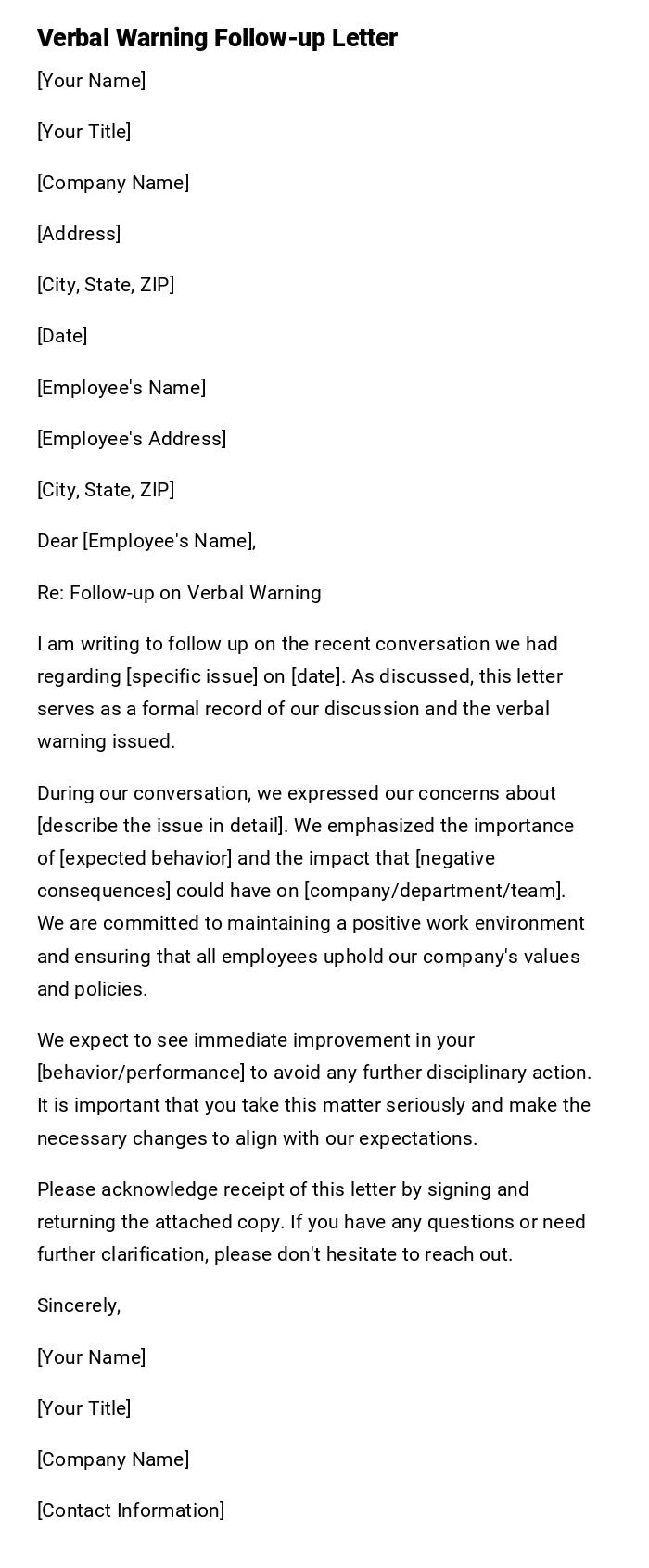
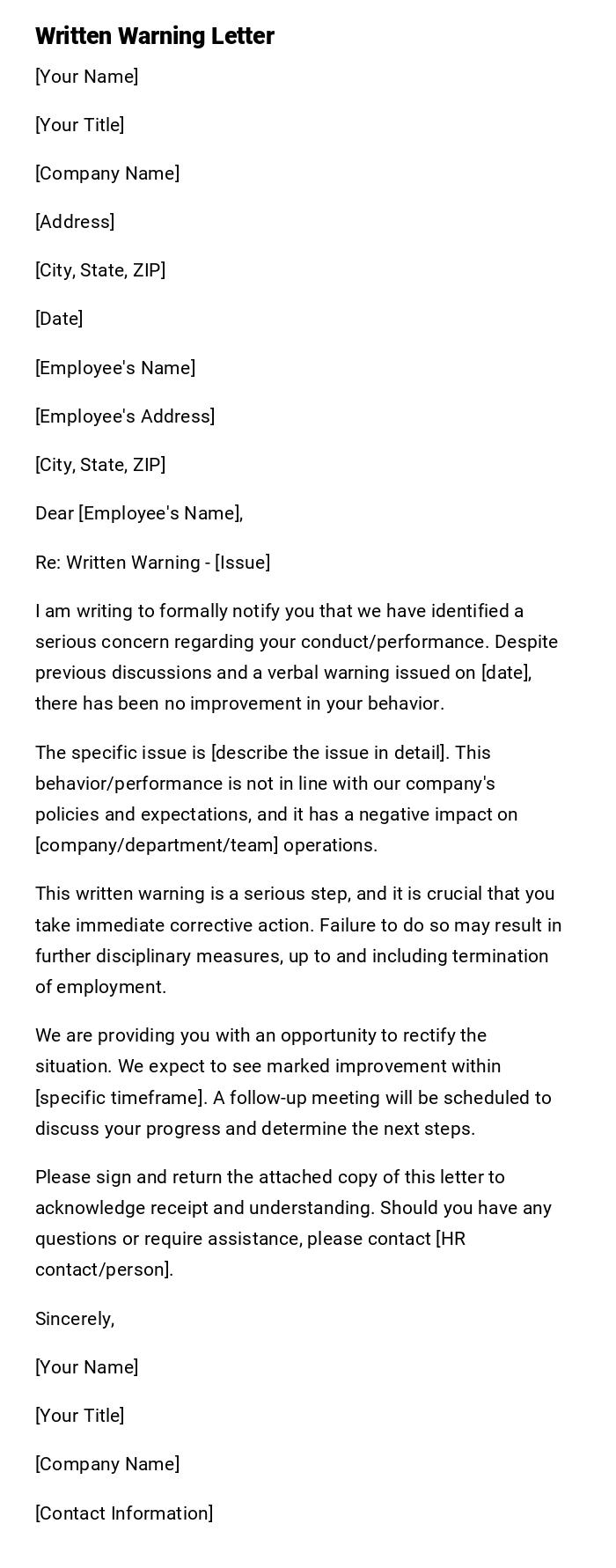
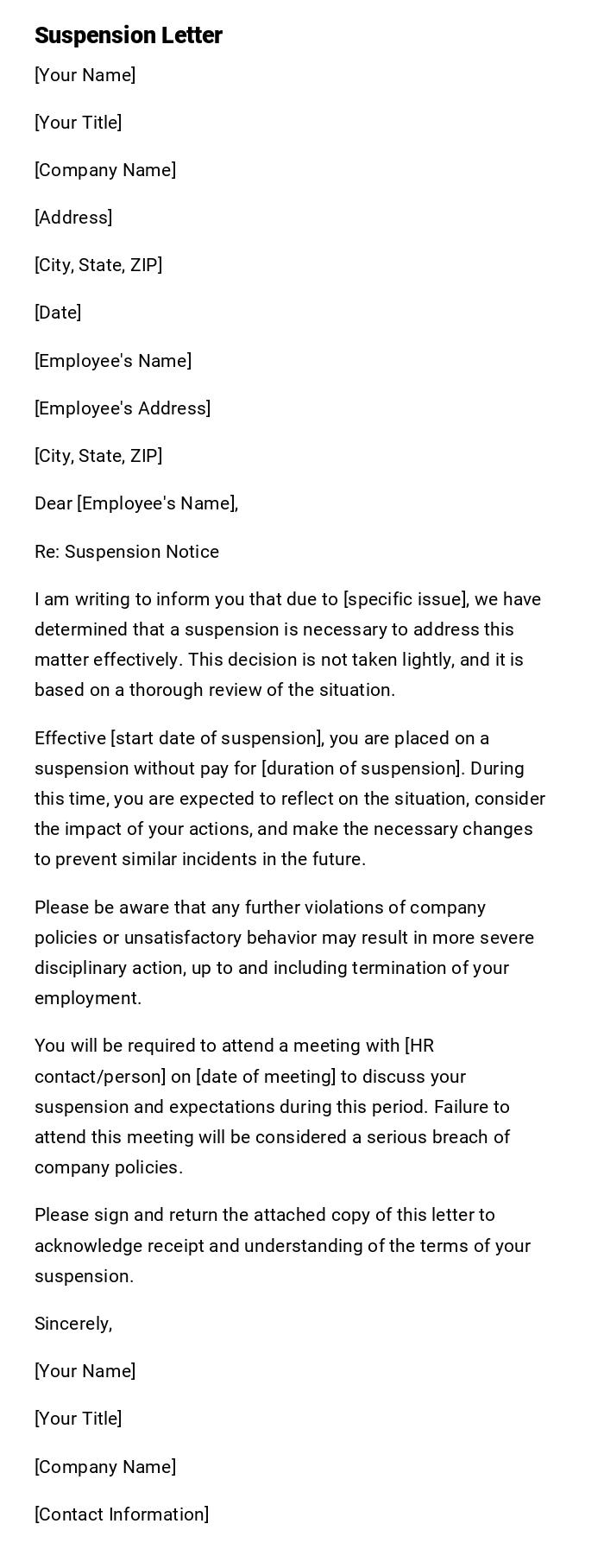
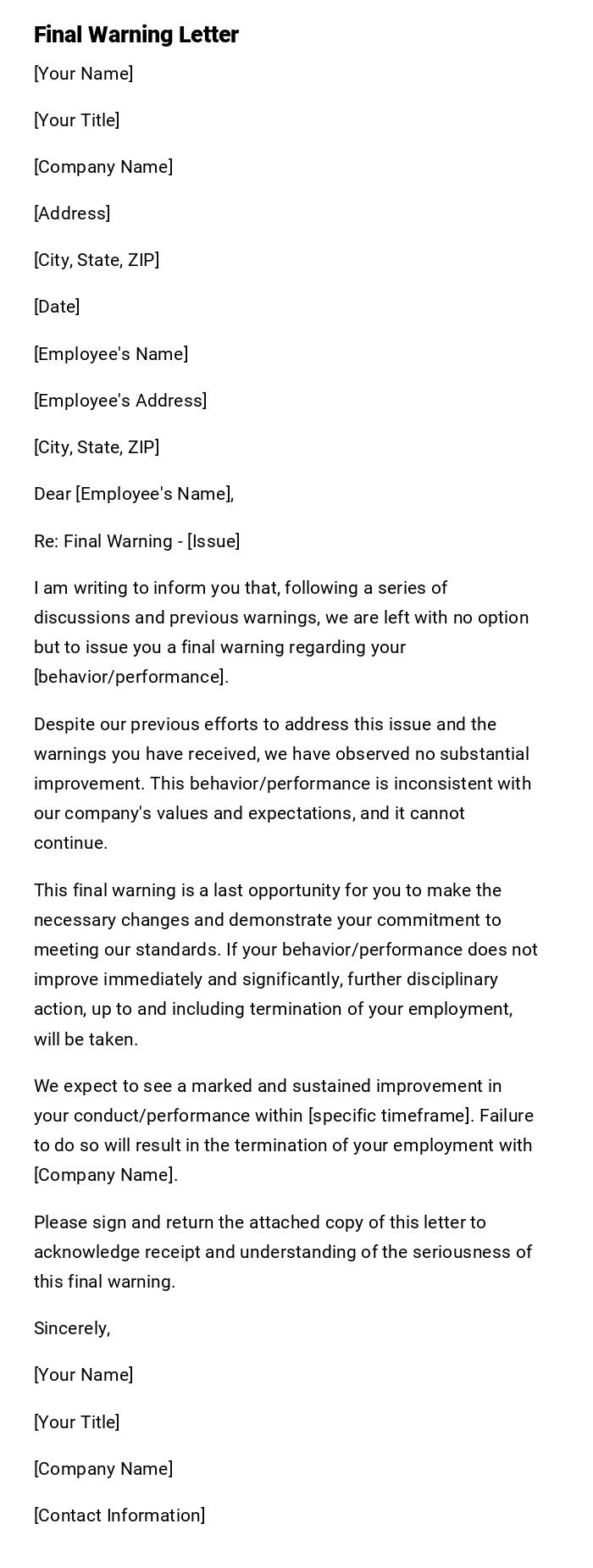
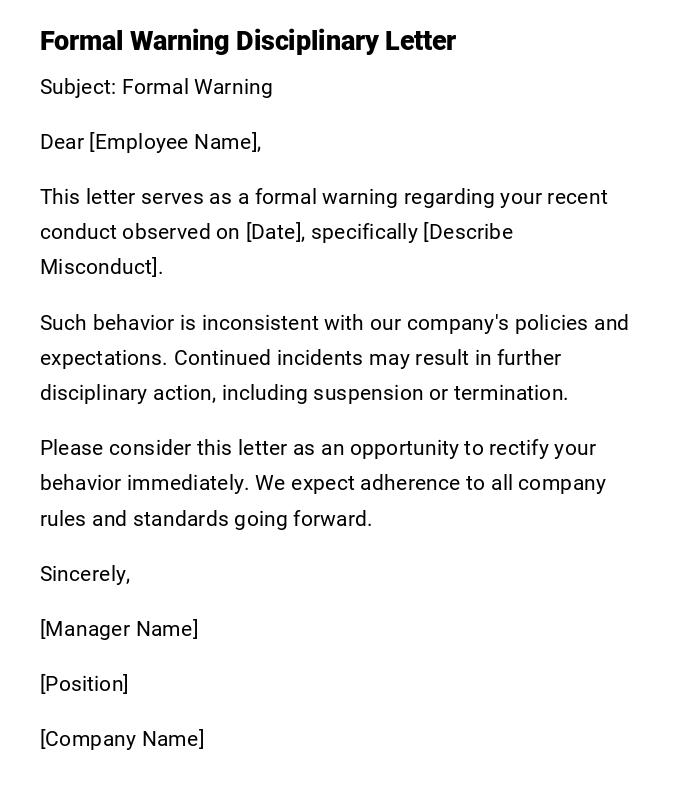
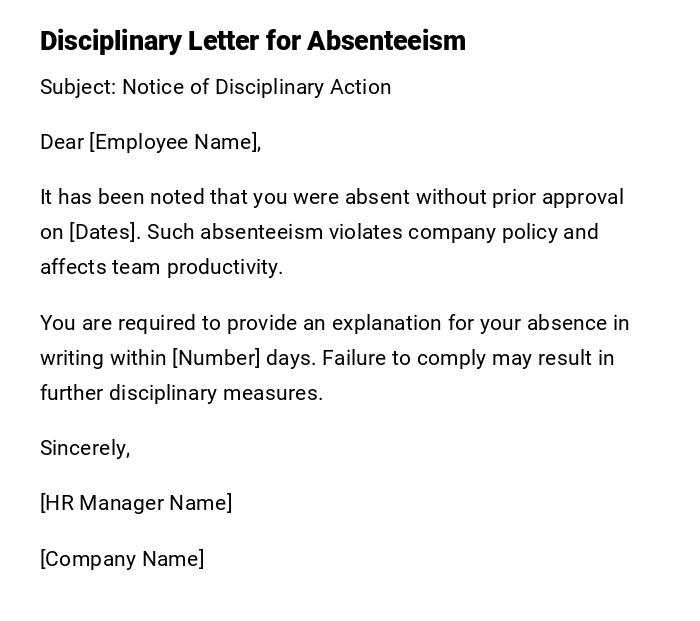
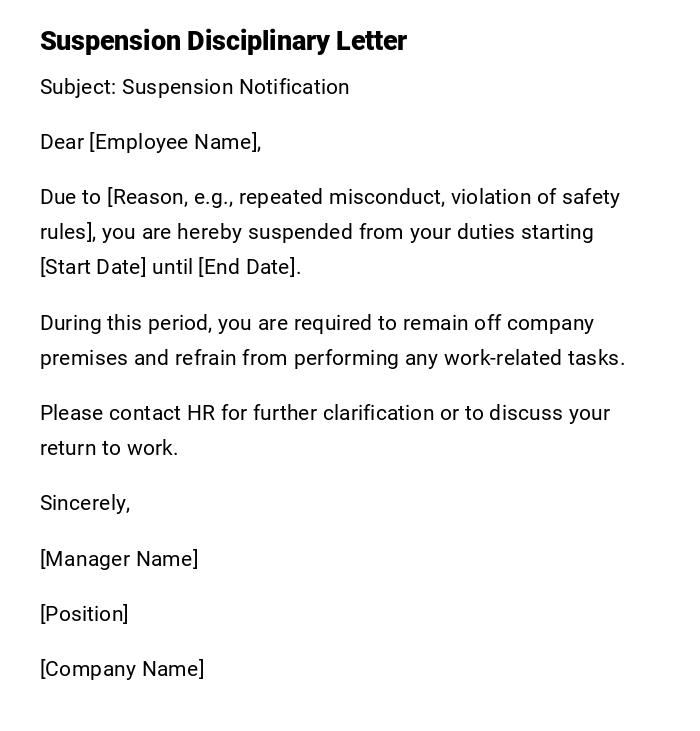
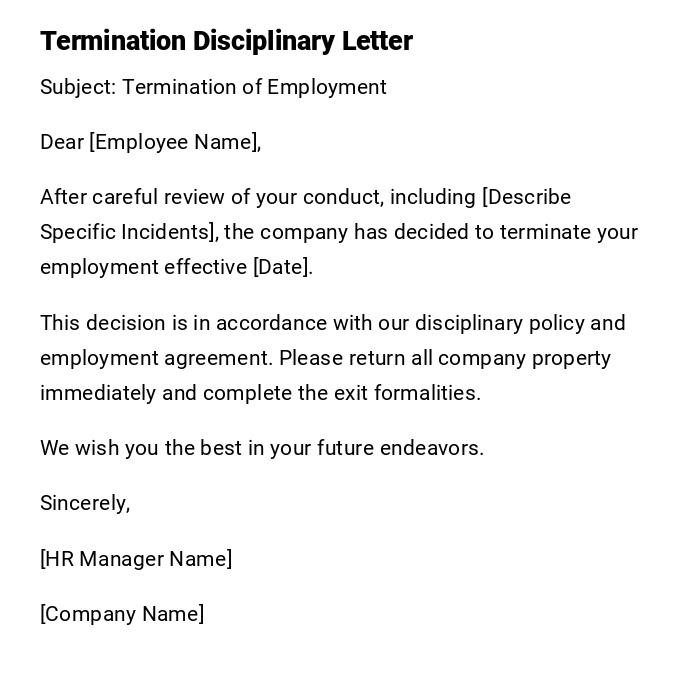
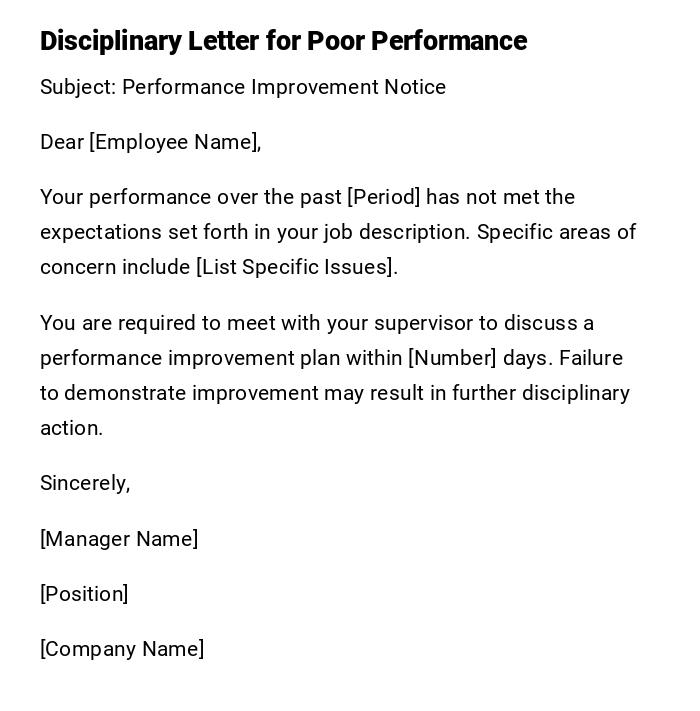
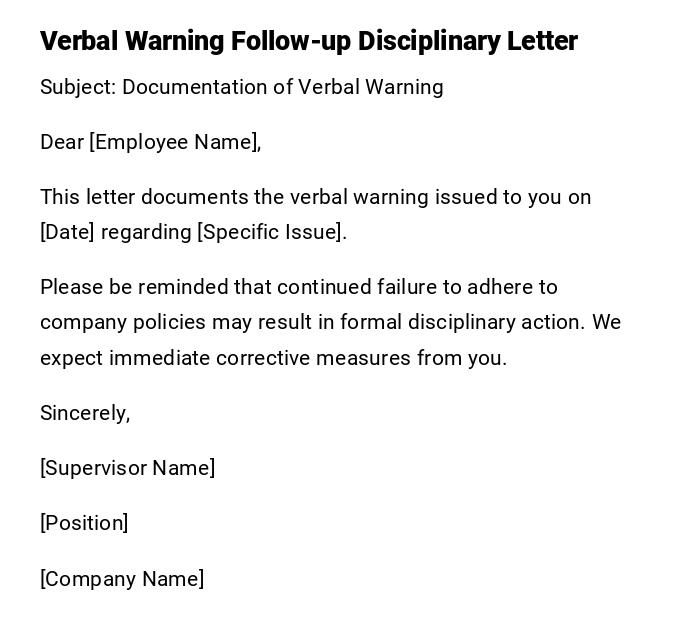
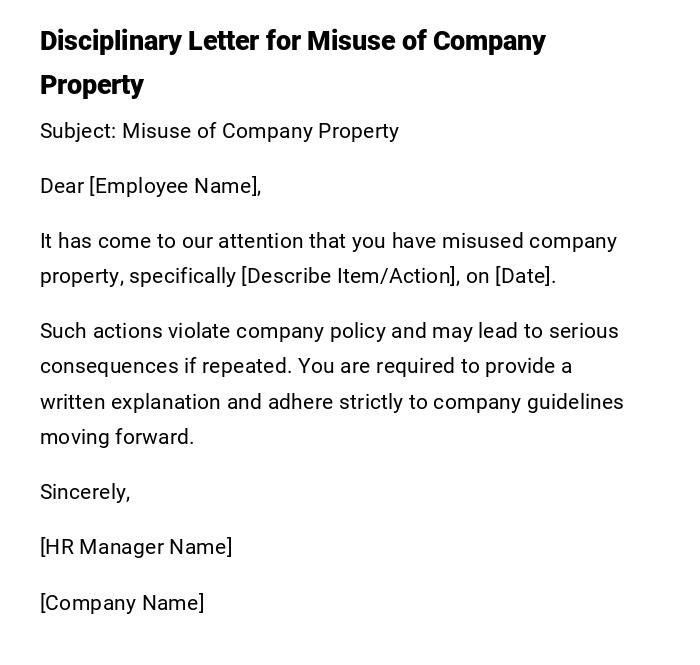
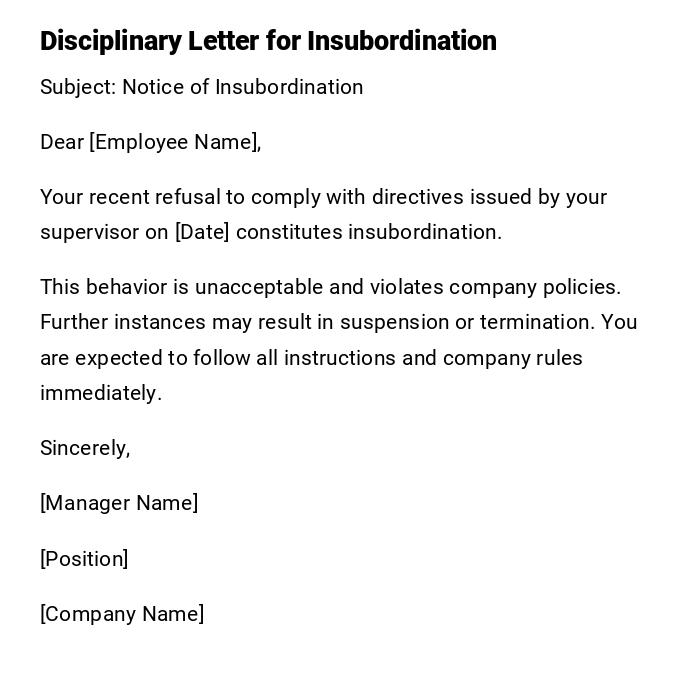

 Download Word Doc
Download Word Doc
 Download PDF
Download PDF